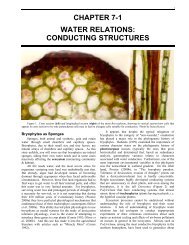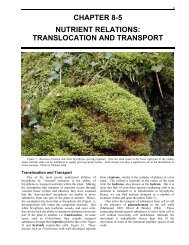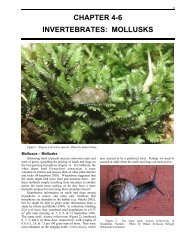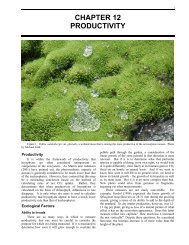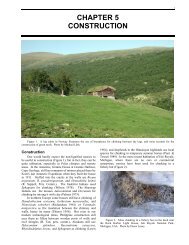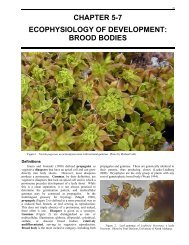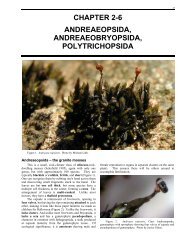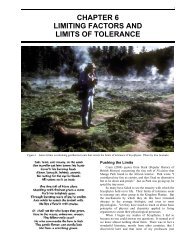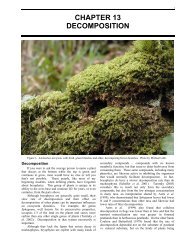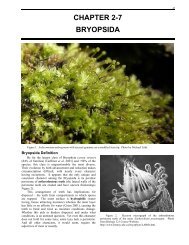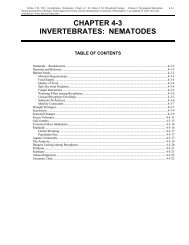Chapter 4-5: Adaptive Strategies - Bryophyte Ecology
Chapter 4-5: Adaptive Strategies - Bryophyte Ecology
Chapter 4-5: Adaptive Strategies - Bryophyte Ecology
Create successful ePaper yourself
Turn your PDF publications into a flip-book with our unique Google optimized e-Paper software.
46 <strong>Chapter</strong> 4-5: <strong>Adaptive</strong> <strong>Strategies</strong>: Growth and Life Forms<br />
making a firmer attachment to the substrate. It would be<br />
interesting to examine competition in these two taxa since<br />
they can occupy the same streams and even the same rocks.<br />
Although many studies describe dominant life forms,<br />
these descriptions are rarely based on quantitative data.<br />
Kürschner (1994) used mean cover values to describe life<br />
forms on basic rocks in nine communities in southern<br />
Germany on the northern border of the Schwaebische Alb.<br />
He found that communities subject to high light and<br />
temperature (photophytic and thermophytic) were<br />
dominated by cushions, short turfs, and perennial and<br />
short-lived colonists (life strategies discussed in the next<br />
chapter). As these graded into shady habitats, wefts and<br />
mats were more common, with perennial shuttle and<br />
perennial stayer life cycle strategies; reproduction was<br />
more "passive." Low light species (sciophytes) and aquatic<br />
species were perennial fan-formers with sexual<br />
reproduction.<br />
Physical Effects on Growth Form<br />
Moss Balls<br />
The strange phenomenon of moss balls was reported in<br />
1912 by Dixon, who referred to them as "mosses growing<br />
unattached." Bryologists still remain fascinated by these<br />
strange organisms that grow in a ball and are mobile, so<br />
that at different times any part of the sphere may be<br />
exposed to sunlight or substrate. But bryologists are not<br />
the only ones fascinated by them. In Japan, a monument is<br />
dedicated to their preservation (Iwatsuki 1977).<br />
In 1874, the United States sent an expedition to the<br />
Kerguelen Islands in the South Indian Ocean to observe the<br />
transit of Venus (Mägdefrau 1987). The surgeon of the<br />
expedition was also an amateur botanist and an avid<br />
collector. He brought back a "curious moss" that seemed<br />
"not to be rooted to another plant, but to be blown about by<br />
the wind indiscriminately," as described by the bryologist<br />
Th. P. James. Schimper later described these same mosses<br />
as having a size that varies between that of a cherry and a<br />
middle-sized potato. The smaller balls were Blindia<br />
aschistodontoides, and the larger ones were formed by<br />
stems of Andreaea parallela by radiating from a central<br />
core of soil or a small pebble. Since then similar windformed<br />
balls have been found in Alaska, Iceland, Norway,<br />
on Mount Ontaka in Japan, and even at the high elevation<br />
tropics of Mount Kenya, Mt. Elgon, and Mt. Kilimanjaro in<br />
Africa.<br />
Such balls in Arctic and alpine areas could result from<br />
solifluction. Solifluction is a slow creeping of fragmented<br />
material down a slope over impermeable material, due to<br />
the viscous flow of water-saturated soil and other surficial<br />
materials, particularly in regions underlain by frozen<br />
ground (not necessarily permafrost) acting as a barrier to<br />
downward water percolation. Its drift typically occurs at a<br />
rate of 1-10 cm per year (White 2001) in relatively cold<br />
regions when the brief warmth of summer thaws only the<br />
upper meter or two of loose earth materials above solid<br />
rock, which becomes waterlogged because the underlying<br />
ground remains frozen and therefore the water cannot drain<br />
down into it. Mosses could travel and tumble with it.<br />
Hedberg (1964) interpreted the African balls (Grimmia<br />
ovalis; Mägdefrau 1987) to form as a result of solifluction.<br />
Mägdefrau (1987) tested this hypothesis by experimenting<br />
with balls in Teleki Valley of Mount Kenya at 4200 m.<br />
The balls were marked and their locations sketched. When<br />
it was dry, there was no solifluction and the moss balls<br />
remained in place. However, when they experienced daily<br />
watering and frost at night, the balls rotated but held their<br />
positions. Rather, it appears that when ice crystals and ice<br />
needles form at night, they cause the mosses to be forced<br />
away from their substrate and broken off. These freed<br />
mosses are blown about continuously and thus grow in all<br />
directions, forming balls.<br />
Mägdefrau (1987) observed that none of the mosses in<br />
balls had sporophytes, whereas those of the same species<br />
growing attached had plentiful sporophytes. He concluded<br />
that the growth of sporophytes is prevented by the rolling<br />
movement. It would seem likely that young setae and<br />
perhaps even archegonia at apices may be damaged by<br />
abrasion as they get beaten around over the rocky surface.<br />
When mosses lie for a longer period of time on one side,<br />
sporophytes develop on the edge of the disk.<br />
On frozen Icelandic soil (Mägdefrau 1982) and<br />
Alaskan glaciers (Shacklette 1966; Heusser 1972; Iwatsuki<br />
1976), dislodged mosses blow about across the surface,<br />
forming similar balls. During (1992) observes that this life<br />
form, which also includes lichen species, results in areas<br />
that have high winds and little vegetation.<br />
Perez (1991) attributes the transport of Grimmia<br />
longirostris moss balls in the Paramo de Piedras Blancas of<br />
the Venezuelan Andes to needle ice activity. These balls<br />
had a high organic content (19%) and a collection of fine<br />
mineral grains (69%), a much higher fine grain than in the<br />
underlying mineral soils. This combination of organic<br />
content and fine grains affords the moss balls a much<br />
higher water retention capability than paramo soil, with<br />
water-holding capacity increasing with the size of the ball.<br />
Wind and ice are not the only sources of creating moss<br />
balls. Action of waves can create similar assemblages<br />
(Figure 17). These strange assemblages of individuals have<br />
been reported from as distant places as Alaska (Iwatsuki<br />
1976), Finland (Luther 1979), Japan (Iwatsuki 1956, 1977;<br />
Iwatsuki et al. 1983), and South America (Eyerdam 1967).<br />
Eyerdam found Fontinalis in balls up to 15 cm in diameter!<br />
In shallow water near lake shores in Hokkaido, Japan,<br />
Drepanocladus (Warnstorfia) fluitans (Figure 16) attaches<br />
to small rocks (Iwatsuki 1956); once the rock is dislodged,<br />
wave action rolls the moss back and forth, causing it to lie<br />
first in one position, then another, with any protruding<br />
branches being broken off (Iwatsuki et al. 1983). These<br />
growths become extremely dense. As the mosses reach<br />
shallower water, wave action is even greater. Ultimately<br />
they may be deposited in great numbers along the beaches.<br />
Stress causes the production of ethylene, and ethylene can<br />
result in short, wide cells under stress conditions in higher<br />
plants (Abeles 1973). This could partly explain the short,<br />
but<br />
firm, branches in the moss balls.<br />
Figure 16. Drepanocladus (Warnstorfia) fluitans growing<br />
normally. Photos by Michael Lüth.




